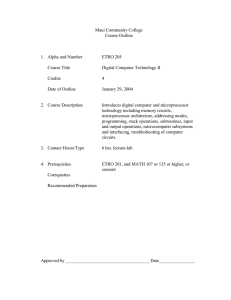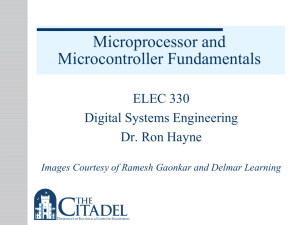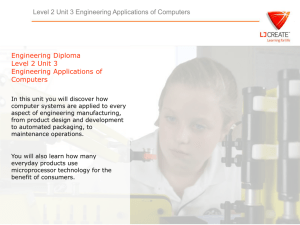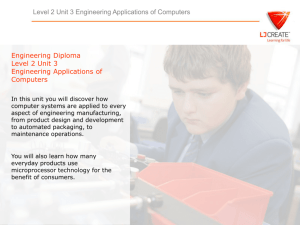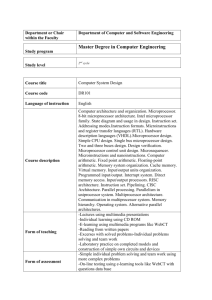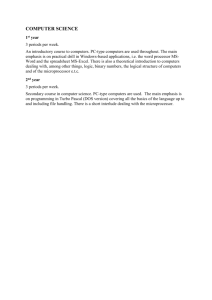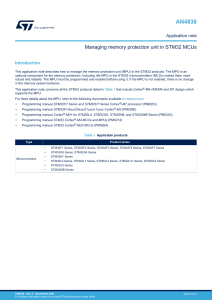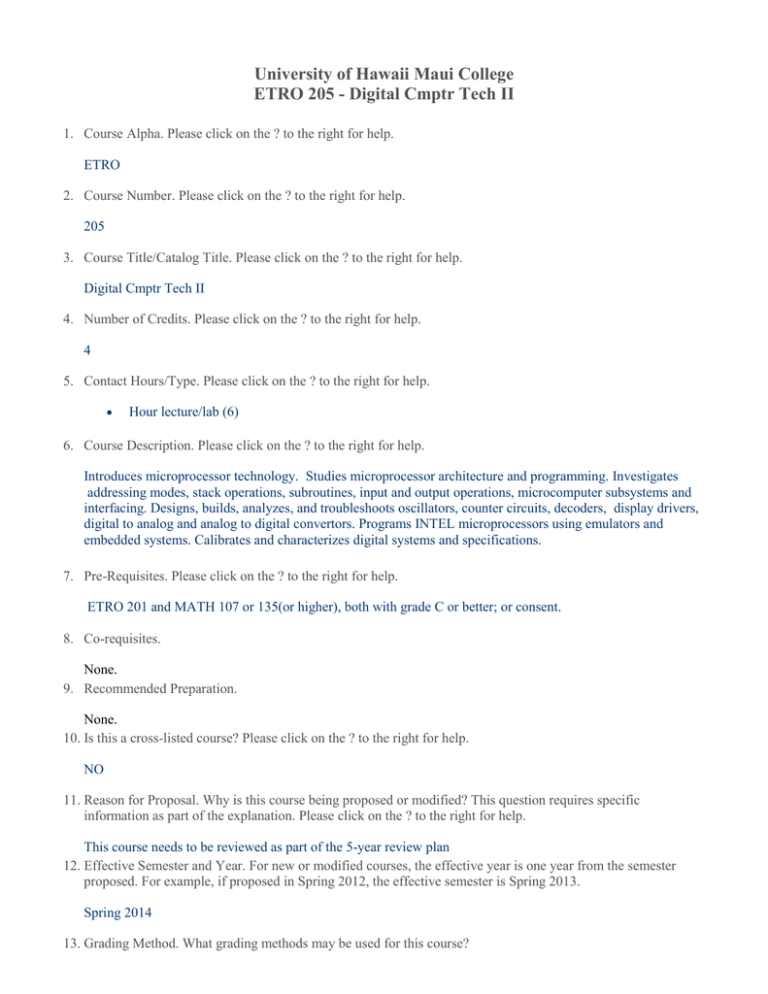
University of Hawaii Maui College
ETRO 205 - Digital Cmptr Tech II
1. Course Alpha. Please click on the ? to the right for help.
ETRO
2. Course Number. Please click on the ? to the right for help.
205
3. Course Title/Catalog Title. Please click on the ? to the right for help.
Digital Cmptr Tech II
4. Number of Credits. Please click on the ? to the right for help.
4
5. Contact Hours/Type. Please click on the ? to the right for help.
Hour lecture/lab (6)
6. Course Description. Please click on the ? to the right for help.
Introduces microprocessor technology. Studies microprocessor architecture and programming. Investigates
addressing modes, stack operations, subroutines, input and output operations, microcomputer subsystems and
interfacing. Designs, builds, analyzes, and troubleshoots oscillators, counter circuits, decoders, display drivers,
digital to analog and analog to digital convertors. Programs INTEL microprocessors using emulators and
embedded systems. Calibrates and characterizes digital systems and specifications.
7. Pre-Requisites. Please click on the ? to the right for help.
ETRO 201 and MATH 107 or 135(or higher), both with grade C or better; or consent.
8. Co-requisites.
None.
9. Recommended Preparation.
None.
10. Is this a cross-listed course? Please click on the ? to the right for help.
NO
11. Reason for Proposal. Why is this course being proposed or modified? This question requires specific
information as part of the explanation. Please click on the ? to the right for help.
This course needs to be reviewed as part of the 5-year review plan
12. Effective Semester and Year. For new or modified courses, the effective year is one year from the semester
proposed. For example, if proposed in Spring 2012, the effective semester is Spring 2013.
Spring 2014
13. Grading Method. What grading methods may be used for this course?
Standard (Letter,Cr/NCr,Audit) (0)
14. Is this course repeatable for credit? How often can this course be counted toward a degree or certificate?
NO
15. Course Student Learning Outcomes (SLOs). DO NOT ENTER TEXT IN THE TEXT BOX BELOW. Click on
the yellow button "COURSE LEARNING OUTCOMES" and enter in that screen.
Competency/Course SLO
Analyze and test Program a
Analyze computer building block circuits
microprocessor microprocessor including MPU, I/O, Power, Data Buss,
circuits.
system.
Address buss and Memory circuits.
Describe INPUT/OUTPUT conditions for a
microprocessor
Identify the architecture of typical MPU
Describe the purpose the instruction set of the MPU
Identify Logic instructions
Describe the purpose of Opcodes and their operations
Identify the voltage thresholds and signals produced by
MPU
Describe operations of Registers and the ALU
Measure waveforms and logic levels of a MPU
Plan and flowchart programs
Write and run program
Identify Move instructions
Use Jump and Flag instructions
Test Call and Returns
Troubleshoot and debug programs
Describe I/O instructions
Use Push and Pop commands
Identify Control and Mask Interrupts
Identify and test I/O devices
Measure outputs of MPU Busses
Course SLO/PSLO
Analyze, design, and Utilize
Demonstrate critical
implement electro- appropriate engineering technology
optic systems, control mathematics skills and experiences
systems,
at the level such as: making existing
instrumentation
of algebra technology operate,
systems,
and
creating/selecting new
communication
trigonometry technology,
systems, computer
to solve
troubleshooting,
systems, or power
technical
calibrating,
systems;
problems; characterizing, and
optimizing;
Demonstrate
engineer's
way of
thinking,
analyzing
technology
as systems.
Analyze and test microprocessor circuits.
Program a microprocessor system.
Analyze computer building block circuits including MPU,
I/O, Power, Data Buss, Address buss and Memory circuits.
16. Course Competencies. DO NOT ENTER TEXT IN THE TEXT BOX BELOW. Click on the yellow button
"COURSE COMPETENCIES/ISSUES/SKILLS" and enter text in that screen. Course competencies are
smaller, simpler tasks that connect to and facilitate the SLOs
Competency
Describe INPUT/OUTPUT conditions for a microprocessor
Identify the architecture of typical MPU
Describe the purpose the instruction set of the MPU
Identify Logic instructions
Describe the purpose of Opcodes and their operations
Identify the voltage thresholds and signals produced by MPU
Describe operations of Registers and the ALU
Measure waveforms and logic levels of a MPU
Plan and flowchart programs
Write and run program
Identify Move instructions
Use Jump and Flag instructions
Test Call and Returns
Troubleshoot and debug programs
Describe I/O instructions
Use Push and Pop commands
Identify Control and Mask Interrupts
Identify and test I/O devices
Measure outputs of MPU Busses
17. Recommended Course Content and Timeline. The course content facilitates the course competencies. Course
content may be organized by weeks, units, topics or the like.
Content
1-2 weeks Introduction to microprocessor fundamentals
1-2 weeks Introduction to instruction sets
1-2 weeks Microprocessor hardware
1-2 weeks Introduction to microprocessor programming
1-2 weeks Algorithms
1-2 weeks Microprocessor programming
1-2 weeks Sub Routine programming
1-2 weeks Input and output programming
18. Program Learning Outcomes. DO NOT ENTER TEXT IN THE TEXT BOX BELOW. Click on the yellow
button "PLOs" and enter text in that screen. Program Student Learning Outcomes (PLOs) supported by this
course. If you are not a "program" use the Liberal Arts PLOs, view them by clicking on ? icon to the right.
Program SLO
Analyze, design, and implement electro-optic systems, control systems, instrumentation systems, communication systems,
computer systems, or power systems;
Utilize appropriate mathematics at the level of algebra and trigonometry to solve technical problems;
Demonstrate critical engineering technology skills and experiences such as: making existing technology operate,
creating/selecting new technology, troubleshooting, calibrating, characterizing, and optimizing;
Demonstrate engineer's way of thinking, analyzing technology as systems.
19. College-wide Academic Student Learning Outcomes (CASLOs). FIRST, fill out the CASLO grid located in the
UHMC tab above. Click on the HELP icon for tips on determining support for the CASLOs and indicate your
choices below by clicking on the box in front of each supported CASLO. NOTE: Our campus does not use the
Preparatory Level, Level 1 and Level 2 designations in the chart below.
Creativity - Able to express originality through a variety of forms.
Preparatory Level
Critical Thinking - Apply critical thinking skills to effectively address the challenges and solve problems.
Preparatory Level
Information Retrieval and Technology - Access, evaluate, and utilize information effectively, ethically, and responsibly.
Oral Communication - Practice ethical and responsible oral communications appropriately to a variety of audiences and
purposes.
Quantitative Reasoning - Synthesize and articulate information using appropriate mathematical methods to solve problems of
quantative reasoning accurately and appropriately.
Preparatory Level
Written Communication - Write effectively to convey ideas that meet the needs of specific audiences and purposes.
GenED SLO
Creativity - Able to express originality through a variety of forms.
Critical Thinking - Apply critical thinking skills to effectively address the challenges and solve problems.
Quantitative Reasoning - Synthesize and articulate information using appropriate mathematical methods to solve problems of
quantative reasoning accurately and appropriately.
20. Linking. CLICK ON CHAIN LINK ICON IN UPPER RIGHT HAND CORNER TO BEGIN LINKING.
21. Method(s) of delivery appropriate for this course. Please click on the ? to the right for help.
Classroom/Lab (0)
22. Text and Materials, Reference Materials, and Auxiliary Materials.
Materials:
Text(s) may be supplemented with:
- Accompanying practice exercises if available
- Articles, handouts and/or exercises prepared by the instructor
- Magazine or newspaper articles
- On-line materials
Other:
-Engineering Notebook
Ronald J. Tocci, Neal S. Widmer, and Gregory L. Moss. Digital Systems: Principles and
Applications. 11th E. Pearson, Prentice Hall, 2011, 978-0135103821.
23. Maximum enrollment. Please click on the ? to the right for help.
The lab has equipment for a maximum of 16 students. With appropriate funding, the program could purchase
more equipment and allow up to 24 students in the lab.
24. Particular room type requirement. Is this course restricted to particular room type?
YES
Lab with all the equipment required to carry out the labs (like KAA 217).
25. Special scheduling considerations. Are there special scheduling considerations for this course?
YES
This course must fit the ECET AS degree course scheduling.
26. Are special or additional resources needed for this course?
Electronics equipment: Power supplies, function generators, oscilloscopes, computers and electronic
components. Logic analyzers, logic probes, digital electronic components, breadboards, LED displays, and
passive electronic components.
Software package: Multisim, EMU 86, Hyperterminal, Hex Editor Neo.
27. Does this course require special fees to be paid for by students? Please click on the ? to the right for help.
NO
28. Does this course change the number of required credit hours in a degree or certificate?
No.
29. Course designation(s) for the Liberal Arts A.A. degree and/or for the college's other associate degrees.
Degree
Program
Category
Associate in Arts:
Liberal Arts
LE - Elective
LE - Elective
ECET - All
AS:
PR - Program Requirement
AAS:
BAS:
Developmental/Remedial:
30. Course designation(s) for other colleges in the UH system.
This course transfers as an elective.
31. Indicate the year and page # of UHMC catalog referred to. For new or modified courses, please indicate the catalog
pages that need to be modified and provide a sheet outlining those changes.
Referred catalog: pages 48 and 114 in UHMC's 2012-2013 general catalog.
Modifications page 48
32. College-wide Academic Student Learner Outcomes (CASLOs).
Standard 1 - Written Communication
Write effectively to convey ideas that meet the needs of specific audiences and purposes.
Outcome 1.1 - Use writing to discover and articulate ideas.
0
Outcome 1.2 - Identify and analyze the audience and purpose for any intended communication.
0
Outcome 1.3 - Choose language, style, and organization appropriate to particular purposes and audiences.
0
Outcome 1.4 - Gather information and document sources appropriately.
1
Outcome 1.5 - Express a main idea as a thesis, hypothesis, or other appropriate statement.
1
Outcome 1.6 - Develop a main idea clearly and concisely with appropriate content.
1
Outcome 1.7 - Demonstrate a mastery of the conventions of writing, including grammar, spelling, and mechanics.
0
Outcome 1.8 - Demonstrate proficiency in revision and editing.
0
Outcome 1.9 - Develop a personal voice in written communication.
0
Standard 2 - Quantitative Reasoning
Synthesize and articulate information using appropriate mathematical methods to solve problems of quantative reasoning
accurately and appropriately.
Outcome 2.1 - Apply numeric, graphic, and symbolic skills and other forms of quantitative reasoning accurately and
3
appropriately.
Outcome 2.2 - Demonstrate mastery of mathematical concepts, skills, and applications, using technology when appropriate.
3
Outcome 2.3 - Communicate clearly and concisely the methods and results of quantitative problem solving.
2
Outcome 2.4 - Formulate and test hypotheses using numerical experimentation.
2
Outcome 2.5 - Define quantitative issues and problems, gather relevant information, analyze that information, and present
results.
3
Outcome 2.6 - Assess the validity of statistical conclusions.
2
Standard 3 - Information Retrieval and Technology.
Access, evaluate, and utilize information effectively, ethically, and responsibly.
Outcome 3.1 - Use print and electronic information technology ethically and responsibly.
0
Outcome 3.2 - Demonstrate knowledge of basic vocabulary, concepts, and operations of information retrieval and technology. 0
Outcome 3.3 - Recognize, identify, and define an information need.
1
Outcome 3.4 - Access and retrieve information through print and electronic media, evaluating the accuracy and authenticity
of that information.
1
Outcome 3.5 - Create, manage, organize, and communicate information through electronic media.
0
Outcome 3.6 - Recognize changing technologies and make informed choices about their appropriateness and use.
1
Standard 4 - Oral Communication
Practice ethical and responsible oral communications appropriately to a variety of audiences and purposes.
Outcome 4.1 - Identify and analyze the audience and purpose of any intended communication.
0
Outcome 4.2 - Gather, evaluate, select, and organize information for the communication.
1
Outcome 4.3 - Use language, techniques, and strategies appropriate to the audience and occasion.
0
Outcome 4.4 - Speak clearly and confidently, using the voice, volume, tone, and articulation appropriate to the audience and
occasion.
0
Outcome 4.5 - Summarize, analyze, and evaluate oral communications and ask coherent questions as needed.
1
Outcome 4.6 - Use competent oral expression to initiate and sustain discussions.
0
Standard 5 - Critical Thinking
Apply critical thinking skills to effectively address the challenges and solve problems.
Outcome 5.1 - Identify and state problems, issues, arguments, and questions contained in a body of information.
3
Outcome 5.2 - Identify and analyze assumptions and underlying points of view relating to an issue or problem.
3
Outcome 5.3 - Formulate research questions that require descriptive and explanatory analyses.
2
Outcome 5.4 - Recognize and understand multiple modes of inquiry, including investigative methods based on observation
and analysis.
2
Outcome 5.5 - Evaluate a problem, distinguishing between relevant and irrelevant facts, opinions, assumptions, issues, values, 2
and biases through the use of appropriate evidence.
Outcome 5.6 - Apply problem-solving techniques and skills, including the rules of logic and logical sequence.
3
Outcome 5.7 - Synthesize information from various sources, drawing appropriate conclusions.
3
Outcome 5.8 - Communicate clearly and concisely the methods and results of logical reasoning.
1
Outcome 5.9 - Reflect upon and evaluate their thought processes, value system, and world views in comparison to those of
others.
2
Standard 6 - Creativity
Able to express originality through a variety of forms.
Outcome 6.1: Generate responses to problems and challenges through intuition and non-linear thinking.
3
Outcome 6.2: Explore diverse approaches to solving a problem or addressing a challenge.
3
Outcome 6.3: Sustain engagement in activities without a preconceived purpose.
2
Outcome 6.4: Apply creative principles to discover and express new ideas.
2
Outcome 6.5: Demonstrate the ability to trust and follow one’s instincts in the absence of external direction
1
Outcome 6.6: Build upon or adapt the ideas of others to create novel expressions or new solutions.
2
33. Additional Information

